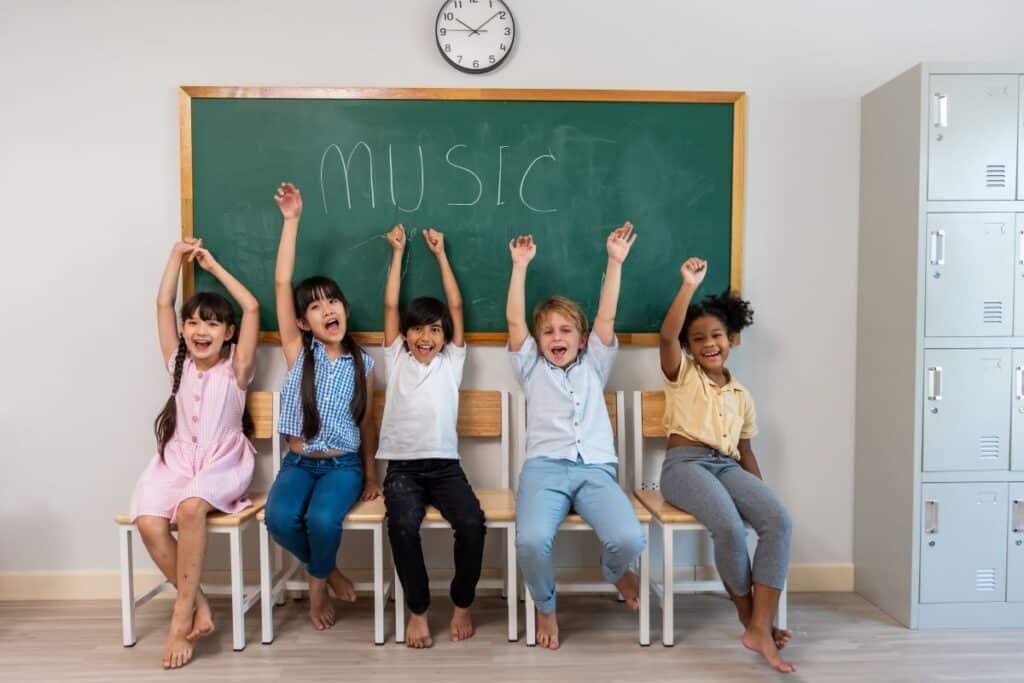Are we truly preparing our students to handle the increasing mental health challenges they face? This isn’t just a question; it’s the reality in our K-12 schools. From the pressure of high-stakes tests to the complex social dynamics of the digital age, today’s students carry an extraordinary amount of stress. While we focus on academic success, we must not ignore how important well-being is to a student’s ability to learn, grow, and thrive.
As educators, we are always looking for accessible, affordable, and proven tools to support our students. What if one of the most powerful resources has been right in front of us, or perhaps even in the classroom, all along? It’s not a new curriculum but a timeless, universal language: music.
For K-12 administrators and teachers, using purposeful musical strategies is not a luxury for the art classroom. It is a key strategy for creating an emotionally supportive learning environment throughout the entire school.
The Neuroscientific Power of Stress and Anxiety Reduction
Music’s ability to influence the brain is well-documented. Research shows that structured musical engagement can reduce anxiety and improve emotional regulation. When students listen to calming music, studies demonstrate significant impacts on psychological well-being and cognitive performance
| Musical Technique | Scientific Mechanism | Practical Application (K-12) |
| Bilateral Stimulation (Headphones) | Alternating sounds stimulate both hemispheres of the brain, aiding in emotional processing and memory integration (similar to EMDR principles). | Use rhythmic, percussive music during high-stress exam periods or transitions. |
| Tempo Matching (Slower Beats) | Listening to music with a tempo of 60-80 beats per minute encourages the listener’s heart rate and breathing to naturally sync, activating the parasympathetic nervous system (rest and digest). | Play slow, calming classical or acoustic music during independent work or mindfulness exercises. |
| Dopamine Release | Engaging with enjoyable music triggers the release of dopamine, a neurotransmitter associated with pleasure and reward, which can naturally counteract feelings of despondency or depression. | Allow students to choose one “focus song” to start their day, giving them an agency-driven positive mental anchor. |
Practical Benefits of Music in the Classroom: By using low-tempo, instrumental music in classrooms without a music focus, during entry, transitions, or independent work, we help students lower their stress levels and reduce cortisol. This allows their brains to be ready for higher-level learning.
Improving Emotional Regulation and Expression
Adolescence brings intense emotions, but many students struggle to express and manage those feelings. Music can help students express what words can’t. Music therapy interventions in K–12 settings allow children to release emotions safely, improving both engagement and well-being.
In special education and inclusive classrooms, music therapy is recognized as a proven support strategy.
Music as an Empathy Builder
When students listen to music, they naturally interpret the emotions in the melody, harmony, and rhythm. Analyzing a song’s mood: “What feeling does the cello express?” allows them to practice recognizing and understanding emotions. This skill enhances their social-emotional learning.
A Way to Release Complex Feelings
For students facing trauma, family stress, or chronic anxiety, discussing their experiences can be too difficult. Playing an instrument, drumming, or writing lyrics provides a safe space and alternative way to communicate. The physical act of drumming or the sad sound of a guitar chord can help release pent-up emotional energy without needing to share verbally.
Key Takeaway: Music education serves as emotional intelligence training delivered through a creative outlet.
Building Social Connection and Reducing Isolation
Feeling like they belong is crucial for positive student wellbeing. Group music activities can quickly create community and break down social barriers.
- Group Performance: Whether it’s a choir, a band, or a simple rhythm circle, making music together requires deep listening and teamwork. Group music experiences have a unique neurochemical benefit. Group singing has been shown to release oxytocin and lower stress. These activities foster a sense of connection and shared success, helping protect against feelings of loneliness.
- Synchrony and Trust: Research shows that group activities involving synchrony, like singing together or drumming in time, release oxytocin, known as the “bonding hormone.” This fosters social trust and cohesion, reinforcing the sense of a supportive school community.
- Administrative Strategy: Support and grow ensemble-based music programs. They are not just for performance; they serve as important social and emotional support for many students.
Enhancing Focus, Attention, and Managing Cognitive Load
While anxiety can weaken executive function, music can strengthen it. This helps students manage attention, switch tasks, and plan, all essential for successful learning.
- Auditory Attention Skills: Learning an instrument requires students to pay attention to rhythm, pitch, tempo, and dynamics all at once. This engaged listening develops the skills needed for sustained attention in class.
- Boosting Working Memory: Reading music and remembering sequences of notes challenges students and directly strengthens their working memory. A stronger working memory helps them manage more information and reduces feelings of being overwhelmed, improving performance in subjects like math and reading comprehension.
- The Mozart Effect (Revisited): While many misunderstand the Mozart effect, its main idea is that engaging with complex music can prepare the brain for solving problems. Taking a short break to listen can refresh a tired mind, not just calm it.
Programs such as the Voices Together initiative demonstrate measurable improvements in student attention and communication through classroom-based music interventions.
Practical Implementation Strategies for the K-12 Environment
Moving beyond the music room, here are simple ways teachers can incorporate the mental health benefits of music into the daily school schedule:
| Setting | Strategy | Mental Health Goal |
| Classroom Music: Entry/Dismissal | Use a “Mood Meter” playlist (e.g., fast/upbeat on Friday, slow/calm on Monday) to help students transition and match their energy to the environment. | Transitions & Mood Setting |
| Hallways/Common Areas | Play carefully curated, non-lyrical, low-volume background music (e.g., Jazz, Classical, Ambient) during passing periods or lunch. | Creating a Calm School Climate |
| Guidance Counseling/SPED | Integrate simple rhythmic instruments (shakers, drums) into counseling sessions as an icebreaker or a means for a non-verbal check-in. | Alternative Expression & Engagement |
| Morning Announcements | Have student musicians record brief, instrumental segments to play before the Pledge of Allegiance or news. | Fostering a Sense of Student Ownership |
Conclusion: Investing in Music is Investing in Mental Health
The evidence is clear: music is not just an elective, it is a strong, proven tool for the mental health and academic success of K-12 students. By recognizing the brain and social benefits of music, administrators and teachers can go beyond traditional reactive methods of well-being and take on a proactive, preventive approach.
Let’s commit to supporting our music programs and helping our colleagues use music as the powerful and accessible resource it truly is. The sound of a regulated, engaged, and thriving school community is the sweetest success we can achieve.
You’ve got important career goals — we have the graduate program to get you there. Check out our available graduate degree programs to advance your career today!




